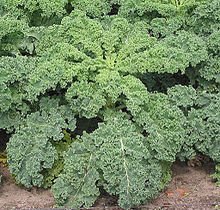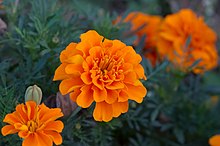Lutein
| Structural formula | ||||||||||||||||||||||
|---|---|---|---|---|---|---|---|---|---|---|---|---|---|---|---|---|---|---|---|---|---|---|

|
||||||||||||||||||||||
| General | ||||||||||||||||||||||
| Surname | Lutein | |||||||||||||||||||||
| other names | ||||||||||||||||||||||
| Molecular formula | C 40 H 56 O 2 | |||||||||||||||||||||
| Brief description |
yellow to red solid |
|||||||||||||||||||||
| External identifiers / databases | ||||||||||||||||||||||
|
||||||||||||||||||||||
| properties | ||||||||||||||||||||||
| Molar mass | 568.88 g mol −1 | |||||||||||||||||||||
| Physical state |
firmly |
|||||||||||||||||||||
| Melting point |
196 ° C |
|||||||||||||||||||||
| solubility |
|
|||||||||||||||||||||
| safety instructions | ||||||||||||||||||||||
|
||||||||||||||||||||||
| As far as possible and customary, SI units are used. Unless otherwise noted, the data given apply to standard conditions . | ||||||||||||||||||||||
Lutein ( lat. Luteus (gold) yellow, orange-yellow, colored with Reseda (luteola)) is an orange-yellow xanthophyll and, along with β-carotene and lycopene, the most common carotenoid . As E 161b , it is approved as a food coloring in the EU .
Occurrence
Lutein is a xanthophyll that is widespread in nature and is always accompanied by zeaxanthin .
High levels are found in dark leafy vegetables (e.g. kale up to 0.25 mg / g fresh weight , spinach up to 0.12 mg / g fresh weight). Tagetes flower petals contain up to 8.5 mg / g fresh weight and are used for the industrial production of lutein. In animal organisms, lutein occurs e.g. B. as a yellow dye in the egg yolk. Lutein and zeaxanthin are the only carotenoids found in the macula of the eye.
Extraction and presentation
The biosynthesis of lutein takes place from α-carotene by hydroxylation of both ionone rings by specific hydroxylases . This biosynthesis, like that of α-carotene, only takes place in plants.
Industrially, it is obtained by extracting parts of plants containing lutein, especially from marigold petals.
properties
Lutein forms orange-yellow crystals that are sensitive to oxidation and heat.
use
Lutein is used as a food coloring (E161b) and as a feed additive, especially for poultry to turn egg yolks yellow .
It is also used as an active ingredient in preparations for the dietary treatment of age-related macular degeneration (AMD); however, the mode of action is unclear. Research has shown that lutein can prevent and alleviate macular degeneration even in old age. The AREDS II study was initiated in 2008 to examine these findings .
Studies
In 2010, a study by the University of Wisconsin – Madison with 1,800 participants showed that the use of lutein and vitamin C can lower the risk of cataracts in women.
Risks of Supplementation - The VITAL Study
The VITAL study (" VIT amins A nd L ifestyle") was a cohort study that was carried out in Washington State from 2000 to 2002 with over 77,000 participants . Its aim was to uncover connections between the intake of vitamins and other nutritional supplements with a possible increased risk of cancer. One of the findings was that long-term use of lutein was associated with a higher risk of lung cancer in women. Despite the large number of participants, the number of lutein users was possibly too small to be statistically significant.
Biological importance
Lutein is part of the light harvesting complexes in chloroplasts . There it increases the energy yield and has a protective effect. It also serves as a lure color in flower petals and fruits. In humans, lutein (in conjunction with zeaxanthin ) plays an essential role in vision.
See also
literature
- F. Granado, B. Olmedilla, I. Blanco: Nutritional and clinical relevance of lutein in human health , in: British Journal of Nutrition , 2003 , 90 (3); Pp. 487-502; PMID 14513828 ; doi : 10.1079 / BJN2003927 PDF (free full text access , English).
Individual evidence
- ↑ Entry on E 161b: Lutein in the European database on food additives, accessed on June 16, 2020.
- ↑ Entry on XANTHOPHYLLS in the CosIng database of the EU Commission, accessed on June 16, 2020.
- ↑ a b Burkhard Fugmann, Susanne Lang-Fugmann, Wolfgang Steglich: RÖMPP Encyclopedia Natural Products, 1st Edition, 2000 . Georg Thieme Verlag, 2014, ISBN 3-13-179551-4 ( limited preview in the Google book search).
- ↑ a b David R. Lide: CRC Handbook of Chemistry and Physics A Ready-reference Book of Chemical and Physical Data . CRC Press, 1995, ISBN 978-0-8493-0595-5 , pp. 98 ( limited preview in Google Book search).
- ↑ a b data sheet Lutein, analytical standard at Sigma-Aldrich , accessed on June 18, 2019 ( PDF ).
- ↑ Vegetables and minerals for cloudy lenses. Report in the Ärzte Zeitung of September 7, 2010.
- ↑ Julie A. Mares, Rick Voland, Rachel Adler, Lesley Tinker, Amy E. Millen, Suzen M. Moeller, Barbara Blodi, Karen M. Gehrs, Robert B. Wallace, Richard J. Chappell, Marian L. Neuhouser, Gloria E. Sarto: Healthy Diets and the Subsequent Prevalence of Nuclear Cataract in Women. Arch. Ophthalmol. 2010; 128 (6): 738-749.
- ↑ JA Satia, A. Littman et al. a .: Long-term use of beta-carotene, retinol, lycopene, and lutein supplements and lung cancer risk: results from the VITamins And Lifestyle (VITAL) study. In: American journal of epidemiology. Volume 169, Number 7, April 2009, pp. 815-828, doi : 10.1093 / aje / kwn409 . PMID 19208726 . PMC 2842198 (free full text).

